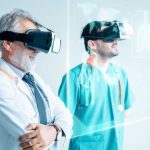
- Client: A network of medical radiology departments.
- Industry: Healthcare, specifically Radiology.
- Challenge: Enhancing collaboration among radiologists with an interactive, immersive experience for analyzing complex 3D medical imagery.
The Challenge
Radiologists and medical professionals faced challenges in effectively collaborating on complex 3D medical images, such as CAT scans and X-rays. The traditional 2D interfaces limited their ability to visualize and interact with these images in detail.
Solution Provider
- Company: Cognilium, a forward-thinking tech company specializing in AR/VR solutions.
- Expertise: Developing immersive AR/VR applications, integrating advanced hardware and software technologies.
Objective
To develop an AR/VR-based video conferencing solution that enables medical radiology workers to collaborate in a virtual environment, interact with 3D medical images, and facilitate a more in-depth analysis and discussion of radiological scans.
Solution Overview
Cognilium developed a cutting-edge solution combining AR/VR technology, Twilio WebRTC for real-time communication, AWS for video streaming and encoding, and Leap Motion hardware for capturing depth imagery of human interactions, all integrated with Oculus VR for an immersive experience.
Implementation
- AR/VR Interface Development:
- Created a user-friendly AR/VR interface allowing radiologists to view, manipulate, and discuss 3D medical images in a virtual space.
- Integrated Oculus VR technology for immersive visualization of medical scans.
- Real-Time Communication with Twilio WebRTC:
- Utilized Twilio WebRTC for seamless, real-time video conferencing capabilities within the VR environment.
- Enabled peer-to-peer communication features for collaborative discussions.
- AWS Video Streaming and Encoding:
- Implemented AWS services for efficient video streaming and encoding, ensuring high-quality visuals of medical imagery.
- Leveraged AWS’s scalability to handle multiple concurrent users without performance degradation.
- Leap Motion Integration:
- Incorporated Leap Motion hardware to capture depth imagery, enabling radiologists to interact naturally with 3D images using hand gestures.
- Enhanced the interactive experience, allowing precise manipulation of image slices and data points.
- Testing and Feedback:
- Conducted extensive testing with medical professionals to refine the interface and user experience.
- Incorporated feedback to ensure the solution met the specific needs of radiologists.
Results
- Enhanced Collaboration: The solution revolutionized how radiologists collaborate, providing an immersive platform for detailed image analysis.
- Increased Accuracy: Improved visualization and interaction with 3D medical images enhanced diagnostic accuracy.
- User-Friendly: The intuitive interface and natural interaction methods were highly praised by medical professionals.
- Scalability: The system could easily accommodate multiple users in different locations, expanding the scope of collaborative radiology.
Conclusion
Cognilium’s innovative AR/VR-based video conferencing solution marked a significant advancement in medical imaging analysis. By enabling radiologists to collaborate in a virtual 3D environment, the solution enhanced the efficiency and accuracy of medical diagnostics.
Future Steps
- Expansion to Other Medical Fields: Explore extending this technology to other areas of medicine, such as surgery planning and educational tools for medical students.
- Continuous Technological Advancements: Keep the system updated with the latest AR/VR and AI developments to further enhance its capabilities.
This case study showcases Cognilium’s expertise in integrating advanced technologies to create impactful solutions in healthcare, demonstrating the potential of AR/VR in transforming medical diagnostics and collaboration.


